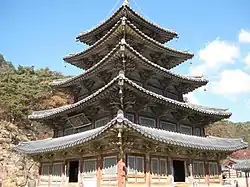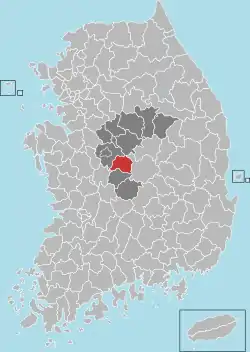Boeun
보은군 | |
|---|---|
| Korean transcription(s) | |
| • Hangul | 보은군 |
| • Hanja | 報恩郡 |
| • Revised Romanization | Boeun-gun |
| • McCune-Reischauer | Poŭn-gun |
 Palsangjeon hall at Beopjusa temple | |
 Flag | |
 Location in South Korea | |
| Country | |
| Region | Hoseo |
| Administrative divisions | 1 eup, 10 myeon |
| Area | |
| • Total | 584.45 km2 (225.66 sq mi) |
| Population (2001) | |
| • Total | 43,245 |
| • Density | 74/km2 (190/sq mi) |
| • Dialect | Chungcheong |
Boeun County (Boeun-gun) is a county in North Chungcheong Province, South Korea.
History
Boeun ( literally "offering gratitude" or "thanksgiving"), was a South Korean town named in 1406 by a remorseful King Taejong, who felt relieved that he had cleared his conscience after having participated in a ceremonial ritual at the local Beopjusa temple to appease the spirits of his dead younger half-brothers, whose deaths he had caused in a power struggle years earlier.[1]
In July 1973, Boeun township was elevated to the status of Boeun town.[2] In 1983, two townships were abolished and incorporated into normal ones. In 2007, Hoebuk-myeon changed its name to Hoein-myeon, Oesongni-myeon to Jangan-myeon, and Naesonngni-myeon into Songnisan-myeonn.[3]
Festivals
- Songnisan Fall Festival: During autumn a festival is held at Songnisan, a celebrated mountain in central Korea. The festival has been an important contributor to the development of tourism and the economy in the region.[4]
- Boeun Ocher Apple Festival: Boeun County is well known for its apples, for which a major festival is held to promote them.
Products
Jujube is the most well-known agricultural product in Boeun county. Additionally, the county's fruit, and eggs are growing in popularity thanks to their eco-friendly mark.[5]
Climate
Boeun has a monsoon-influenced humid continental climate (Köppen: Dwa) with cold, dry winters and hot, rainy summers.
| Climate data for Boeun (1991–2020 normals, extremes 1972–present) | |||||||||||||
|---|---|---|---|---|---|---|---|---|---|---|---|---|---|
| Month | Jan | Feb | Mar | Apr | May | Jun | Jul | Aug | Sep | Oct | Nov | Dec | Year |
| Record high °C (°F) | 14.4 (57.9) |
21.9 (71.4) |
26.2 (79.2) |
31.2 (88.2) |
34.2 (93.6) |
34.2 (93.6) |
37.3 (99.1) |
38.2 (100.8) |
32.8 (91.0) |
29.5 (85.1) |
25.1 (77.2) |
17.4 (63.3) |
38.2 (100.8) |
| Mean daily maximum °C (°F) | 3.2 (37.8) |
6.0 (42.8) |
11.9 (53.4) |
18.8 (65.8) |
23.8 (74.8) |
27.1 (80.8) |
28.9 (84.0) |
29.5 (85.1) |
25.4 (77.7) |
20.1 (68.2) |
12.8 (55.0) |
5.3 (41.5) |
17.7 (63.9) |
| Daily mean °C (°F) | −2.9 (26.8) |
−0.6 (30.9) |
4.8 (40.6) |
11.2 (52.2) |
16.7 (62.1) |
21.1 (70.0) |
24.0 (75.2) |
24.3 (75.7) |
19.1 (66.4) |
12.2 (54.0) |
5.6 (42.1) |
−1.0 (30.2) |
11.2 (52.2) |
| Mean daily minimum °C (°F) | −8.4 (16.9) |
−6.6 (20.1) |
−1.8 (28.8) |
3.7 (38.7) |
9.8 (49.6) |
15.7 (60.3) |
20.3 (68.5) |
20.4 (68.7) |
14.0 (57.2) |
6.0 (42.8) |
−0.3 (31.5) |
−6.4 (20.5) |
5.5 (41.9) |
| Record low °C (°F) | −25.4 (−13.7) |
−21.9 (−7.4) |
−18.3 (−0.9) |
−7.4 (18.7) |
−1.2 (29.8) |
4.6 (40.3) |
10.4 (50.7) |
9.4 (48.9) |
0.8 (33.4) |
−7.0 (19.4) |
−12.3 (9.9) |
−20.4 (−4.7) |
−25.4 (−13.7) |
| Average precipitation mm (inches) | 23.4 (0.92) |
33.0 (1.30) |
47.5 (1.87) |
82.2 (3.24) |
92.8 (3.65) |
156.4 (6.16) |
306.0 (12.05) |
296.6 (11.68) |
137.4 (5.41) |
56.6 (2.23) |
45.2 (1.78) |
28.2 (1.11) |
1,305.3 (51.39) |
| Average precipitation days (≥ 0.1 mm) | 7.3 | 6.7 | 8.2 | 8.5 | 8.1 | 9.5 | 16.7 | 14.7 | 9.3 | 6.1 | 8.1 | 8.2 | 111.4 |
| Average snowy days | 8.9 | 6.7 | 2.8 | 0.2 | 0.0 | 0.0 | 0.0 | 0.0 | 0.0 | 0.2 | 2.0 | 6.6 | 27.2 |
| Average relative humidity (%) | 66.6 | 63.1 | 59.9 | 58.2 | 62.8 | 69.2 | 76.8 | 77.4 | 76.7 | 73.9 | 70.5 | 68.9 | 68.7 |
| Mean monthly sunshine hours | 167.0 | 178.0 | 211.5 | 223.6 | 243.9 | 206.0 | 159.5 | 177.4 | 178.5 | 195.5 | 158.4 | 157.8 | 2,257.1 |
| Percent possible sunshine | 55.9 | 58.2 | 57.4 | 59.5 | 57.0 | 49.7 | 40.1 | 46.4 | 51.3 | 59.9 | 53.8 | 54.0 | 53.2 |
| Source: Korea Meteorological Administration (snow and percent sunshine 1981–2010)[6][7][8] | |||||||||||||
Symbols
- City Flower: Forsythia
- City Tree: Jujube tree
- City Bird: Magpie Birds
Twin towns – sister cities
Boeun is twinned with:
References
- ↑ Official website, Origin
- ↑ Regulations concerning establishment of towns (eups)(1973-03-12)
- ↑ Allowance of alteration concerning from cities to townships (ris)(1983-01-10) from Constitution of the Republic of Korea Currently, Boeun is composed of 1 eup (Boeun-eup) and 10 myons. One of the myons, Maro-myon of which capital is kwanki-ri is famous for Han-woo (Korean traditional cow) and the beautiful scenery in Ku-byong mountain.
- ↑ Official page of Boeun County http://english.boeun.go.kr/ Archived 2007-12-26 at the Wayback Machine
- ↑ 보은군내 친환경농산물인증 농가 2배 증가 The confirmation of eco mark doubles Newsis 2008-01-10
- ↑ "Climatological Normals of Korea (1991 ~ 2020)" (PDF) (in Korean). Korea Meteorological Administration. Archived from the original (PDF) on 29 January 2022. Retrieved 4 April 2022.
- ↑ 순위값 - 구역별조회 (in Korean). Korea Meteorological Administration. Retrieved 4 April 2022.
- ↑ "Climatological Normals of Korea" (PDF). Korea Meteorological Administration. 2011. Archived from the original (PDF) on 7 December 2016. Retrieved 8 December 2016.
- ↑ "La Cité Clarence Rockland - Twin Cities". www.clarence-rockland.com. Retrieved 2021-03-01.
